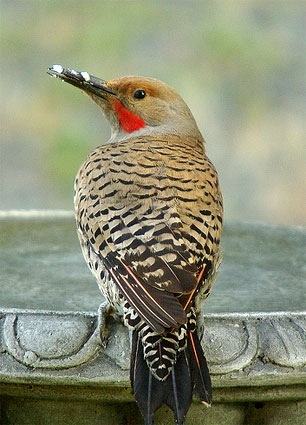BIRDER ALERT – BIRDER ALERT
Here is another article by Gary Kline, recalling another bird out of his boyhood, the Flicker. Two Flickers (hopefully a mating pair) were seen lately (February 2012) at Black Lake Organic, but this article comes out of notes from a February 2011 sighting at Gary and Suzanne’s home. We hope you enjoy reading about the Flicker.
Flickering Sounds
After a long absence, we have a Flicker in our neighborhood – – – a welcome sight and sound. This Flicker actually comes to our feeder, clings to the perch, and evidently eats the millet seed, which surprises me.
The Flicker is a large, brown Woodpecker, in between the size of the Downy and Pileated Woodpeckers. Although it does peck on wood, unlike other Woodpeckers, the Flicker spends a lot of time on the ground feeding on ants. Now, there’s a niche! As it flies up, it reveals a white rump and, usually, you see a bright, salmon-red or else yellow flashing of its underwing feathers, and therein lies a coloration controversy.
On the morning of February 13th, 2011, I heard the Flicker, calling in flight. The call is distinctive, indelible, and unmistakable. What is that loud, proud call that tells us “all is well”? Is it a cluck, a clack, or maybe a flick? Actually, this is the sound that gives the Flicker its name, as some people think they hear a “flick” or succession of flicks (or flickerings?). I always kind of suspected that’s where the name came from, but to my ear that was a stretch. I thought, also, that the name might have come from a habit of flickering its wings when excited. In any case, the call says to me Iowa, boyhood and paradise – – – even as I knew back then that paradise was becoming a parking lot.
When I first moved out to Black Lake in 1976, I was working as a wildlife biologist for the U.S. Fish and Wildlife Service. An early memory was of rousing a Flicker out of the small shed in back of our garage, where it had undoubtedly become accustomed to spending the nights. I would hear them around, and occasionally they came right into our yard and then seemed to be gone for a long while. So seeing this bird back was a good sign and brought me comfort.
Whatever one might call that call, and however unmelodious, whenever I hear it, it is sweet music that transports me immediately to more pleasant, peaceful, and simpler times. For me, it is the call of the wild, and wild is beautiful and infinitely precious. Sorry if you and others don’t hear it that way; sorry for you and sorry for them.
The Flicker illustrates, if not embodies, a rare and unsettling scientific hair-splitting problem in ornithology. Depending on how you count them, there are two or three species of Flickers. One of those is the Gilded Flicker, associated with the Giant Cactus region of the desert Southwest. Disregard that one for now.
Where I grew up, we had the Yellow-Shafted Flicker, and when I lived on the south side in Des Moines, we had a giant boxelder tree (I believe it was) that had the upper half blown out by a storm, and the Flickers drilled a nest hole near the top of the broken-off section. After the Flicker family moved out, a pair of Screech Owls moved in and raised a family.
As a kid, I knew there was a Red-Shafted Flicker that was found in the western U.S., and I may have seen some of those in Iowa. The main difference was in the color of their underwings, but really there is a lot of difference in color and markings on their heads, with the Yellow-Shafted having a black moustache, and the Red-Shafted a red one. Both species have black ladder-like bars across brown backs, unlike other members of the rather numerous species of North American Woodpeckers, perhaps half of which I’ve been fortunate enough to see.
In my 1966 Birds of North America book (Robbins, etal), the Yellow-Shafted is listed as Colaptes auratus, and the Red-Shafted as Colaptes cafer, and that’s the way it ought to be as the two birds are very different, if only due to their underwing coloration. But no, the ornithologists had to go lump them together as the Northern Flicker Colaptes auratus and call them one species. Never mind that a Southern Flicker probably doesn’t exist. In my Sibley’s Field Guide to Birds of Western North America, published in 2003, you will see that both are indeed listed as C. auratus, distributed clear across North America, with the Yellow-Shafted named a subspecies, even though we know auratus comes from the root word aurum, meaning gold. So now red is gold.
Lest I seem unscientific, I had better relent and accept the lumping. In truth, the two birds do “intergrade”, producing all sorts of colorations and in-between pattern markings. In fact, I think some individuals have been seen that have a black moustache on one side and red on the other. Orangish and mixed, red and yellow underwing feathers (shafts) are sometimes seen, I believe I saw one or more myself somewhere in the distant past. What this represents is speciation in the making, and evidence of evolution going on in plain sight.
As if on cue, the day after I drafted this Flicker article, there was a Flicker clinging to our bird feeder, and the next morning, one in our driveway at the store. That’s good because I need to put something in here to bring the article to a close. What more can I say? I come back to what the Flicker says to me, in sight and sound; its disposition, so to speak.
To me, the Flicker emanates a sense of peace, and minding one’s own business, asking to get along, let me be, bask in the greatest, longest-running reality – – – which is wild nature. The Flicker knows, appreciates, and loves being in that reality. It’s only natural. If we do not dwell there and do not protect the magnificence we were handed, we will (and do) suffer from the alienation we have created. Hardly a creation story. GLK
;
© 2012 Gary L. Kline
;
All Rights Reserve
Black Lake Organic







